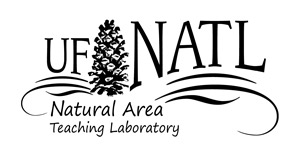
NATL's Invasive Exotic Plants
More on NATL's invasive exotic plants can be found on the Invasive Control page.
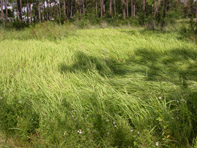 |
Cogongrass in old-field plots Cogongrass, a native of southeast Asia, is well established in NATL's old-field plots and is threatening to crowd out most other species in Plot A, where this picture was taken. An all-out effort to eradicate it with herbicides was begun in spring of 2005. This has resulted in large patches of dead grass that are temporarily resistant to decay and to invasion by native species. |
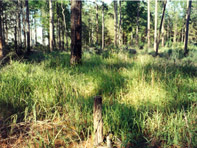 |
Cogongrass in upland pine ecosystem Cogongrass is more shade tolerant than most grasses. As seen in this picture, it has begun to spread from NATL's old field plots into the eastern edge of the adjacent upland pine. Herbicidal control is under way here also. More about cogongrass in Florida. |
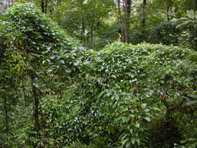 |
Skunkvine in hammock ecosystem Skunkvine, a native of Asia, gets its name from the fetid odor of its foliage. It overgrows and shades out native vegetation. Vines sometimes drop from above, take root, and provide the means for more vines to ascend to the tree tops. A large patch of skunkvine is established in NATL's restricted area hammock on either side of Gasline Trail. An attempt to eradicate the patch with herbicides is underway. More on skunkvine in Florida. |
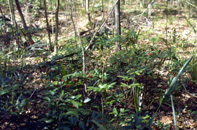 |
Coral ardisia in hammock ecosystem Coral ardisia is a small shrub native to southeast Asia that has dark evergreen foliage and bright red berries. It tends to form a dense understory in moist hammocks thereby displacing native species in the ground cover. A major infestation in southeast NATL-west was greatly reduced by hand pulling. Scattered patches remain throughout NATL's hammocks and are being reduced by hand pulling. More on coral ardisia in Florida. |
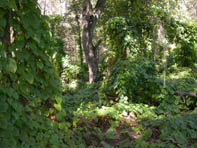 |
Air potato in hammock ecosystem Air potato has a growth form and aggressiveness that resembles kudzu. Its fruit, borne on the vines in the fall, resemble small, pale Irish potatoes. Small patches occur in NATL-west and a major infestation on adjacent property, shown here, has invaded NATL-east along its eastern boundary. Herbicidal control has suppressed but not eliminated air potato in NATL. More on air potato in Florida. |
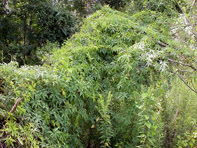 |
Alamo vine in old-field plots Alamo vine can be recognized by its distinctive foliage. It was first found in NATL in 2005 covering these small trees. Because it was new to NATL and seemed potentially invasive, this patch and others found later were sprayed with herbicide. Even though the species continued to spread, spraying was soon suspended--because the threat seemed slight and some considered the species native to Florida (based on William Bartram having found it there in 1773). |
